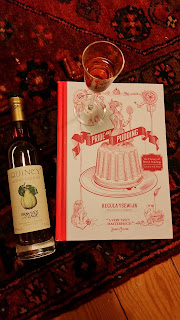'Pride and Pudding' was another unexpectedly gorgeous book. One that I thought sounded interesting and which then went on to so utterly exceed expectations that I'm a bit evangelical about it. Regula Ysewijn (Missfoodwise on Instagram, her pictures are a treat) is a Belgian food historian and photographer (artist is probably a better description) who has written this fantastic book about the history of puddings in Britain. She's also just written a book about Belgian cafe culture which I hopefully put on my Christmas wish list, but nobody seems to have taken the hint yet (please, somebody, anybody, take the hint).
The history of the puddings themselves is fascinating, especially if food history is your thing (it is mine). The recipes come in original and updated forms, and there's all sorts of interesting things in here. Some probably best just read about, quite a lot on a list of things to make at some point. What really makes this book though is the illustrations. Both Ysewijn's photographs which are inspired by Dutch and Flemish still lives from the Renaissance onwards, and her husband, Bruno Vergauwen's exquisite illustrations. They're hard to describe in a way that does them justice - all I can say is go and have a look at the book. It's altogether a magical object.
The part of my imagination that's fascinated by antique recipes is the same part that can't resist an unusual sounding liqueur, especially if it has a hint of the romantic about it. It's not an impulse that's always served me well, notable failures have included an expensive holly eau de vie that everybody who tried it loathed, a creme de coquelicot (poppy) which tasted like cough medicine, was a lurid red, and eventually went down the sink, and a homemade rhubarb affair which tasted like nothing so much as cabbage.
Bramley and Gage's Quincy, quince liqueur, is a happy exception to my general run of bad luck in that direction. It tastes like baked quinces smell and is as mellow and golden as you could hope for. It is infinitely nicer than the quince brandy I tried making last year. It's around £15 for a half bottle and would work particularly nicely with an apple pie or a cheeseboard. Buying it, rather than trying to make it, is likely to save a lot of trouble (and possibly disappointment - at least until I find a fail safe recipe) it's going to cost about the same as well, and as its both a little unusual and enjoyable to drink it's worth seeking out.
I guess quinces are making something of a comeback in that it's possible to buy them on farmers markets, in specialist grocers, and in Waitrose - which is all to the good. The trees are beautiful, and there are a lot more recipes around for them each year (again my experience with them is mixed - great jelly, never quite been happy with anything else), and they have history which brings me back to the hint of romance.

Allow me to introduce you to Sue who says that she is the custodian of a quince tree. She writes beautifully about a lot of things and her recipes are excellent.
ReplyDeletehttp://thequincetree65.blogspot.co.uk/2010/10/quince-diaries-2.html
Thank you! I make a very good quince jelly (Diana Henry's recipe from Salt Sugar Smoke) but I haven't had much luck with the other things I've tried. There's a tree in the park next door to me, its fruit tantalisingly out of reach, but heavens, it's a pretty thing.
ReplyDelete